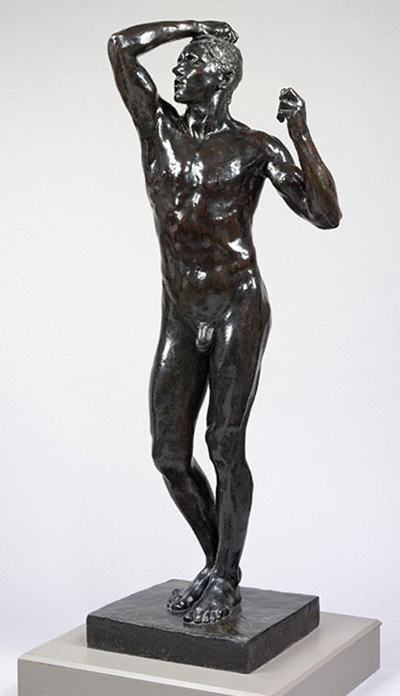The bronze statue known as The Age of Bronze was executed by Auguste Rodin, who was a French Sculptor. The figure that Auguste sculpted is of a life-size naked male measuring 72 inches high. Auguste continued producing casts of this statue for a few decades after the statue was modelled in 1876.
Auguste Rodin had a 22-year-old soldier(Neyt) from Belgium pose for this statue and kept the pictures that survived in the Philadelphia, Pennsylvania-based art museum called Rodin Museum. Neyt had survived the Franco-German War, and it is clear that the artist wanted to use the experience of this soldier to draw a realistic depiction of a soldier by using the personality of the model to bring out a certain mood plus emotion. Neyt understood the concept and stated that Auguste wanted a natural attitude that's as realistic as life itself.
As one of the artist's first solo pieces and also his first that was exhibited at the Paris-based Salon, this statue highlights Auguste's natural capability of capturing the character of the models he produced and of portraying movements as well as feelings in his sculptures.
Why Did Auguste Choose to Sculpt It?
Auguste's original design for this sculpture was capturing the demoralisation of the veterans who fought in the War of 1870 (Franco-German War), which lasted from 19 July - 28 January 1871. The initial title for the work was Le Vaincu or The Vanquished, which was more relevant to Auguste's original meaning for this work than the 2nd title, which was given after the accusation that the artist produced a cast of a model instead of one that's carved by hand. Also, some critics described Le Vaincu as being anti-French plus it was criticising the government for making the decision about going to war. Auguste was keen to avoid this because he was still looking for commissions from the government of France.
Inspiration
Auguste worked on the life-size nude male for one and a half years. During this time, between February and March 1876, the artist embarked on a journey to Italy, where he admired Michelangelo's work. In a burst of intense and eager interest, upon returning to Brussels, Auguste finished the sculpture, then presented it in 1877 at the Cercle Artistique.
As with many of Auguste's influences for this piece, several artists like Delaplanche, Falguière, Mercié and Paul Dubois, also tried creating realism by using supple modelling. Auguste is famous for his capabilities with clay and also when he was starting his career as a sculptor, he had the capability of manipulating clay in a way that made the bronze cast appear lucid and supple.
Details of the Sculpture
The pose of this figure and the raised arm are heroic; this contrasts very well with the face and this depicts a sense of spirituality. Some critics describe this as 'ecstasy'. The hip is seen protruding, which serves the purpose of adding motion to the sculpture. The artist thought this was important when he created the sculpture as a classic part of the entire sculpture.
The work was inspired mainly by classical sculpture, but the work of art was modelled more naturally. Initially, Auguste had a staff in the composition he had created and by removing it, he managed to add a more modern approach to a classic form and also created movement in the static composition.
Tone and Emotion
The mood of this piece gives viewers a glimpse of Auguste as an innovator. Unlike most of the sculptors of his time, Auguste chose not to follow the symbolism that was popular in the nineteenth-century sculpture. Instead, the artist put his focus on the rendering of his sculpture's face and body and what it could capture.
Techniques Used
Auguste's working techniques combined a strong response to the body of humans and enjoyment in free, spontaneous modelling and drawing. The sculptor viewed the creation of sculpture as a process that's collaborative. He used highly trained plaster casters, studio assistants and carvers founders, to turn his models into a finished work.
One of the most notable characteristics of Auguste's work was the movement: He demonstrated this when he created The Age of Bronze. The artist decided the pose for this work of art based on a classical sculpture that was in Rome, Italy, where young men were usually rendered holding something. It is believed that Auguste used to sketch his models numerous times before beginning his modelling. He also used to ask them to move while sketching them so as to learn the realistic way that the body of humans moves.
Perspective
The life-size piece is very realistic that critics thought it was cast directly from the model, which was considered as a great artistic tactless act during Auguste's lifetime. It was vital for the artist to create a realistic piece because he disliked the sentimental idealism that was dominating other sculpture of his period. To do this, Auguste modelled the piece in such a way that viewers could look at it from every angle and also they could view it as if they were looking at the model himself.




